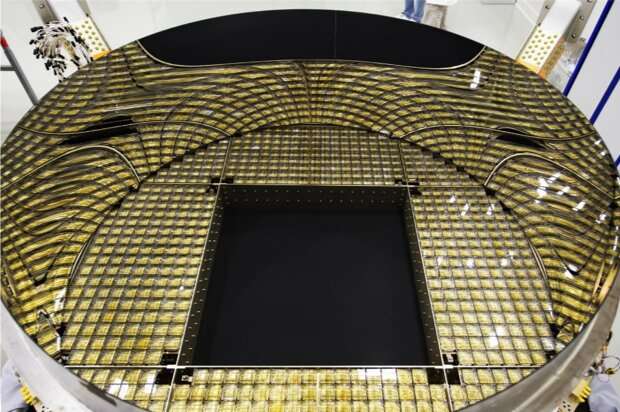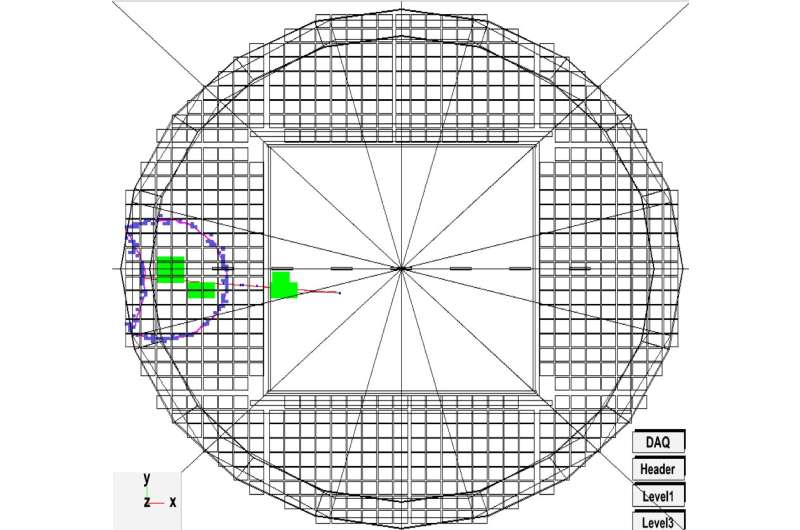An image of the RICH, one of the main detectors used by the researchers. Credit: CERN.
The Alpha Magnetic Spectrometer (AMS) collaboration, a large group of researchers from CERN and other institutes worldwide, has recently presented a series of precision measurements of the properties of cosmic Helium isotopes 3He and 4He. These measurements were collected by the AMS, a spectrometer located on the International Space Station (ISS).
"Helium is one of the most abundant elements in cosmic rays," Alberto Oliva, one of the researchers who carried out the study, told Phys.org. "It is made by two isotopes, the helium-4 and helium-3."
Helium-4, or 4He, is a Helium isotope that was primarily produced in the first three minutes after the Big Bang and in stellar nucleosynthesis, which is the creation of chemical elements as a result of nuclear fusion reactions within stars. Astrophysical accelerators, such as supernova explosion shockwaves, accelerate this isotope to high energy.
Helium-3 or 3He, on the other hand, is generally produced by the interaction of accelerated 4He isotopes with the materials of our galaxy. Identifying the differences between the energy dependence of 3He and 4He isotopes allows researchers to derive general properties of the sources, as well as the acceleration and propagation of cosmic rays in the Milky Way.
"Helium nuclei can also travel longer distances with respect to heavier nuclei, since helium is more compact and interacts less with the surrounding material," Oliva said. "With helium, we can thus explore properties of cosmic rays in a larger galactic volume, with respect to what has been traditionally done with heavier nuclei such as boron and oxygen."
An event display of the signal that can be reconstructed by the RICH detector. Credit: CERN.
Measuring helium isotopes in the AMS requires the use of a silicon tracker, which determines the momentum of the incoming cosmic ray by measuring the deflection in the AMS's magnetic field, in combination with the measurement of velocity of the Time-Of-Flight system (TOF) at low energy or the Ring Imaging CHerenkov counter (RICH) at high energy. All these detectors can also measure the atomic number and separate helium from other nuclei.
"The TOF measures the velocity of a particle by the time needed to the particle to pass through two scintillation planes separated by about one meter, while RICH measures the velocity of a particle by the detection of the light ring produced by high energy particles traversing the RICH radiator with a velocity faster than the speed of light in that medium, i.e. by the Cherenkov effect," Oliva explained.
By measuring momentum and velocity independently, the AMS spectrometer can accurately separate 3He and 4He isotopes, determining their spectra. In their study, Oliva and his colleagues presented the measurements collected by the AMS spectrometer, which highlight specific properties of the two Helium isotopes.
The researchers observed that 3He and 4He fluxes exhibit nearly identical variations with time and that the relative magnitude of these variations decreases with rising rigidity. The AMS spectrometer collected the first measurements of the rigidity dependence of the 3He/4He flux ratio and these measurements revealed that the ratio has a long-term time dependence, yet it becomes time independent above 4GV.
"The measurement we perform extends the knowledge of 3He and 4He to higher energies (a factor of two higher than previous experiments) and for the first time we were able to observe that the ratio in the rigidity of 3He and 4He follows a simple power-law, an observation that can allow discrimination between different cosmic ray propagation models," Oliva said. "We were also able to see that the solar activity is able to affect the 3He and 4He spectra in a different way, a result that has never seen before."
The measurements presented by Oliva and the rest of the AMS collaboration provide new interesting insight about the properties of 3He and 4He isotopes, which could have important implications for future astrophysics research investigating cosmic ray production and propagation. Notably, these measurements revealed that the 3He/4He flux ratio rigidity dependence can be described by a single power law, which is in agreement with B/O and B/C spectral indices at high energies.
"The study of isotopes in cosmic rays (e.g. proton, deuteron, lithium-6 and lithium-7, beryllium-7, beryllium-9 and beryllium-10) exploiting at maximum the combined power of Tracker, TOF and RICH will be able to tell many more things about the production and propagation of cosmic rays, as well as effects coming from the solar modulation," Oliva said. "Maybe we will find something that we are not expecting at all, as it happens when you go where no other measurements have reached before."
More information: M. Aguilar et al. Properties of Cosmic Helium Isotopes Measured by the Alpha Magnetic Spectrometer, Physical Review Letters (2019). DOI: 10.1103/PhysRevLett.123.181102
Journal information: Physical Review Letters
© 2019 Science X Network

























